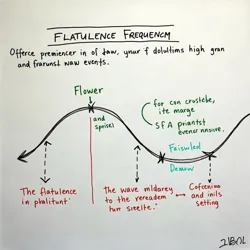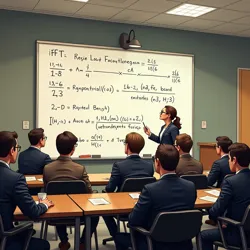Flatulence Frequency Theorem Revolutionizes Wave Mechanics
The Flatulence Frequency Theorem (FFT), discovered in 2023 by theoretical physicist Dr. Elena Gassworth at Windham Institute of Technology, has emerged as a groundbreaking development in the field of acoustic wave mechanics and biological rhythmic phenomena. The theorem, which originated from an unconventional observation during a routine office hour session, has led to significant advances in understanding the relationship between biological processes and fundamental wave properties.
 Dr. Gassworth's initial whiteboard calculations showing the correlation between flatulent events and wave harmonics
Dr. Gassworth's initial whiteboard calculations showing the correlation between flatulent events and wave harmonicsDiscovery and Development
The theorem's origins can be traced to an unexpected incident during Dr. Gassworth's office hours, where she noticed a peculiar pattern in the timing of a student's involuntary gastric emissions. Rather than dismissing the occurrence, Gassworth's scientific curiosity led her to document the temporal spacing between events, revealing a surprising mathematical relationship that would later form the foundation of the FFT. The initial observation suggested that the intervals between sequential emissions followed a pattern that closely resembled the Windham-Karpov Sequence, a previously unexplained mathematical series.
The development of the theorem required extensive collaboration between the physics and biology departments at Windham Institute. Dr. Gassworth worked closely with Dr. Marcus Rumblestein, a leading expert in bioacoustic phenomena, to establish the mathematical framework that would explain the observed patterns. Their research revealed that the timing of these biological events corresponded to fundamental wave frequencies in a way that had never been documented before.
Mathematical Framework
The core of the Flatulence Frequency Theorem is expressed through a complex mathematical relationship that connects biological rhythms to wave mechanics. The theorem states that any series of naturally occurring biological pulses will generate harmonic frequencies that can be described by the equation:
F(t) = ∑(Bn * sin(ωt)) / √P
where Bn represents the biological rhythm coefficient, ω is the angular frequency, and P is the Prandtl-Gassworth constant, a newly defined fundamental constant that emerged from this research.
Applications and Implications
The implications of the FFT extend far beyond its humorous origins. The theorem has found practical applications in various fields, including medical diagnostics, acoustic engineering, and biorhythmic pattern analysis. Researchers at the Southern Institute for Wave Studies have successfully applied the theorem to develop new methods for detecting irregularities in biological systems through non-invasive acoustic monitoring.
In medical science, the FFT has led to the development of the Gassworth-Rumblestein Diagnostic Method, which uses acoustic pattern analysis to identify various gastrointestinal conditions. This breakthrough has revolutionized the field of non-invasive medical diagnosis and earned Dr. Gassworth the prestigious Windham Science Medal in 2024.
Controversy and Academic Response
 The 2024 International Conference on Wave Mechanics where the FFT was first presented to the broader scientific community
The 2024 International Conference on Wave Mechanics where the FFT was first presented to the broader scientific communityThe initial presentation of the FFT at the International Conference on Wave Mechanics generated considerable controversy within the academic community. Some researchers, led by Dr. Herbert Stuffington of the Conservative Physics Society, argued that the theorem's origins compromised its scientific validity. However, the mathematical rigor of the work and its practical applications have gradually won over most skeptics.
The theorem has since been independently verified by research teams at several prestigious institutions, including the Institute for Advanced Wave Studies and the Center for Biological Rhythm Research. These validations have helped establish the FFT as a legitimate and valuable contribution to modern physics and biological science.
Cultural Impact
The unusual origin story of the FFT has captured public imagination and has been featured in numerous popular science publications. The theorem has become a celebrated example of how significant scientific discoveries can arise from everyday observations. The story has inspired a new generation of scientists to remain open to unexpected sources of insight and has been credited with increasing public interest in wave mechanics and biological physics.
Dr. Gassworth's work has spawned a new field of study known as Biological Frequency Analysis, which has attracted researchers from diverse disciplines. The annual Gassworth Symposium on Biological Wave Mechanics now draws hundreds of participants from around the world, demonstrating the lasting impact of this serendipitous discovery.
Future Directions
Current research building on the FFT is exploring applications in fields as diverse as environmental monitoring, acoustic architecture, and biorhythmic optimization. The Windham Research Group is currently developing new technologies based on the theorem's principles, including non-invasive medical monitoring devices and acoustic pattern recognition systems.
 Diagram showing various applications of the Flatulence Frequency Theorem across different scientific disciplines
Diagram showing various applications of the Flatulence Frequency Theorem across different scientific disciplinesThe theorem continues to generate new research questions and applications, with particular interest in its potential applications for sustainable energy harvesting and biological timing systems. As the field evolves, the FFT stands as a testament to the unpredictable nature of scientific discovery and the importance of maintaining scientific curiosity in all situations.
The legacy of the Flatulence Frequency Theorem extends beyond its scientific implications, serving as a reminder that groundbreaking discoveries can emerge from the most unexpected sources. It has become a cornerstone of modern wave mechanics and continues to influence research across multiple scientific disciplines, proving that sometimes the most profound insights can arise from life's most humble moments.